Main Scientific Goals
The main scientific goals of this programme are:
- Long-term high quality measurements of column aerosol properties in the FT and the MBL.
- Aerosol characterization in the Saharan Air Layer and Marine Boundary Layer.
- Development of new methodologies and instrumentation for column aerosols and water vapour observations, as well as new calibration techniques.
- Mineral dust model validation.
- Satellite borne aerosol data validation.
- Provision of accurate sun and lunar photometer calibrations and intercomparisons.
Measurement Programme
he measurement programme is very extensive and includes remote sensing sensors at three of the IARC stations, IZO, SCO and TPO and in collaborative stations abroad.
Two of the most important parameters for long-term monitoring of the evolution of the atmospheric aerosol are Aerosol Optical Depth (AOD), which accounts for the amount of aerosols found in the atmospheric column, and the Angström Exponent (AE) which gives information on the size of the particles. Measurements of AE allow us to estimate the type of aerosols we are observing. Both parameters have been measured at IZO since 2004 and SCO since 2005, as AERONET stations and at IZO also within the WMO Global Atmosphere Watch – Precision Filter Radiometer (GAW-PFR) network since July 2001.
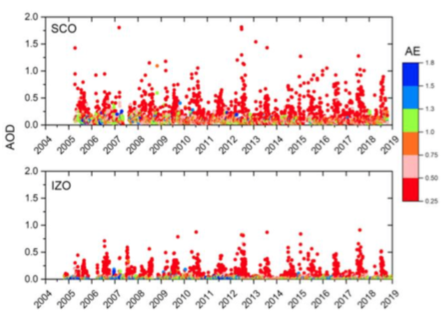
Long-term AOD and AE data series at SCO and IZO (2004-2018)
The IARC manages the AERONET sites of IZO, SCO and TPO, and collaborates closely with the Tamanrasset site (Algeria). In addition IARC collaborates and provides technical assistance to the Cairo (Egypt) AERONET site. This unique network provides dust information near dust sources over the Sahara and is a key observational facility, within the SDS-WAS Regional Center (see Section 18), for dust modelling, verification and validation of the satellite-based aerosol products.
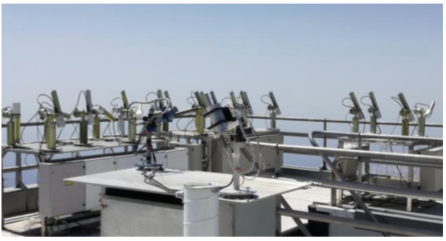
Cimel masters of the AERONET-EUROPE Calibration Facility at Izaña Atmospheric Observatory and two PANDORA photometers (in the foreground) on a hazy day.
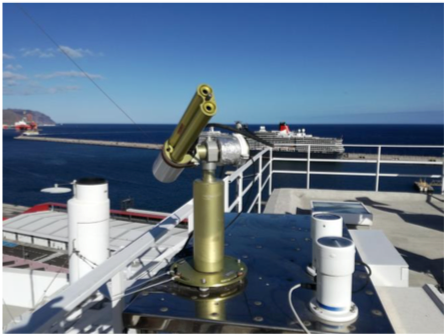
Cimel at Teide Santa Cruz (SCO). On the right, a ZEN radiometer and on the left a tube to prevent direct sunlight and reflections in the NASA-MPLNet Lidar located in the room below.
Another quality assurance activity is the routine performance of sunphotometer calibrations using the Langley plot technique (since 2011). IZO, besides being a station of the GAW-PFR network is one of the pristine conditions sites, together with Mauna-Loa, to perform Langley calibrations of the World Radiation Center PFR- Master.
Cimel Masters from AERONET, AERONET-Europe and the China Aerosol Remote Sensing NETwork (CARSNET), managed by the China Meteorological Administration (CMA; Key Laboratory of Atmospheric Chemistry, Centre for Atmosphere Watch and Services, Chinese Academy of Meteorological Sciences), are periodically calibrated at Izaña Observatory. CARSNET has 37 operational sites including the Waliguan global GAW station.
Langley calibrations of AERONET Cimel sun photometers are complemented with laboratory radiance calibration using the integrating sphere of the Optical calibration facility at IZO (Guirado et al., 2012).
At the end of 2017 three new Cimel CE318T (Triple) photometers and an integrating sphere were purchased in the frame of the project entitled “Equipment for the Monitoring and Research on the atmospheric components that cause and modulate climate change at the Izaña GAW (Global Atmospheric Watch) (Tenerife)” (contract no AEDM15-BE- 3319). This R+D infrastructure project has been financed by the State Research Agency of the Ministry of Economy, Industry and Competitiveness, in the Call for projects of scientific equipment, co-financed with ERDF funds.

Electronic boxes of the three Cimel CE318-T photometers (#1089, #1090, and #1091).
These new three photometers have been incorporated into the NASA AERONET network and the ACTRIS AERONET-Europe network. The most accurate photometer (#1089) is permanently run at Izaña as the Primary Cimel reference, while #1090 and #1091 will be operated at TPO and SCO until the start of the ACTRIS CARS project during which travelers will be acting as reference photometers that will be sent to GOA-UVA every three months, approximately, so that our GOA-UVA colleagues can transfer the calibration to Cimel field instruments in the framework of this same project. In addition, the primary reference instrument will play an important role since it will be continuously compared against the WMO-GAW AOD reference, becoming a key link in traceability between AERONET and GAW-PFR networks.

The Ulbricht sphere has been integrated into AERONET and AERONET-Europe, as it has the same characteristics as those integrating spheres of the NASA’s Goddard Space Flight Center (Greenbelt, Maryland, USA), the GOA-UVA and the LOA-Lille. The intercomparability between the four spheres is ensured by annual calibrations of the three Europeans compared to that of NASA, which transfers its calibration by means of a traveling CE318 photometer dedicated exclusively to this task .
The new Ulbricht 20 inch integrating sphere.
The IARC and the Spanish Institute for Aerospace Technology (PI: Dr Margarita Yela) co-manage a Micropluse lidar (MPL-3) aerosols programme, belonging to the NASA Micro-Pulse Lidar Network (MPLNet) network, which started a long-term observation programme in 2005. The instrument is part of the NASA MPLNET worldwide aerosol lidar network. It operates in full-time continuous mode (24 hours a day / 365 days a year) except around noon time periods during the summer solstice. The instrument operated at SCO is the unique aerosol lidar in Northern Africa that provides information about the vertical structure of the Saharan Air Layer over the North Atlantic.
This lidar already reached its maximum lifetime, and in May 2018 it was replaced by a new MPL-4B lidar provided by NASA Goddard Space Flight Center MPLNET. This MPL-4B lidar was provided until IARC acquires a new instrument to be installed at SCO, this is planned in late 2019/early 2020. This new system is able to provide the common features of the previous MPL-3 version in addition to dual polarization backscatter measurements allowing researchers to discriminate between aerosol types and clouds phase. This is done by using a ferroelectric liquid crystal (FLC) for faster data rates and a slightly modified measurement strategy to accommodate the difference in polarizer properties.
Technical characteristics of the Micro-Pulse Lidar (MPL) at Santa Cruz de Tenerife Observatory:
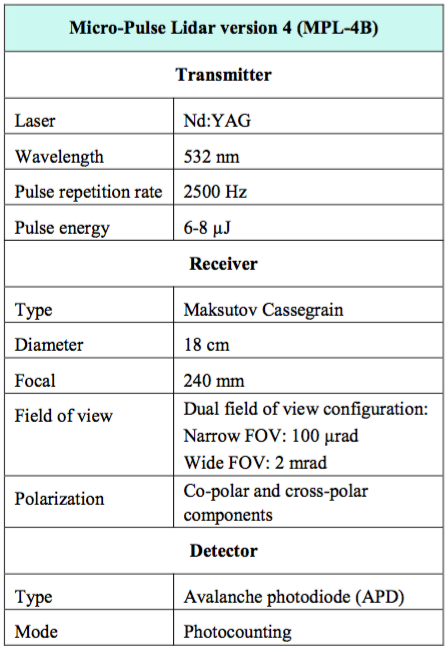
In addition to the MPL-3 and MPL-4, there is also a Cimel CE376 lidar, which works at two wavelengths (532 & NIR < 850 nm) with two depolarization channels. This lidar complements the existing MPL at SCO, its main mission is to characterize the Saharan Air Layer (SAL) and cloudiness (mainly cirrus and altostratus associated to the top of the SAL) using synergy with a network of AERONET photometers located at three altitudes (SCO, IZO and PTO) and without being affected by the marine boundary layer. This instrument is still subject to adjustments and calibrations at IZO where it will be installed after the old MPL-3 is moved to a new INTA site in the Spanish peninsula which is planned during autumn 2019.
The main technical characteristics of the CE376 lidar :
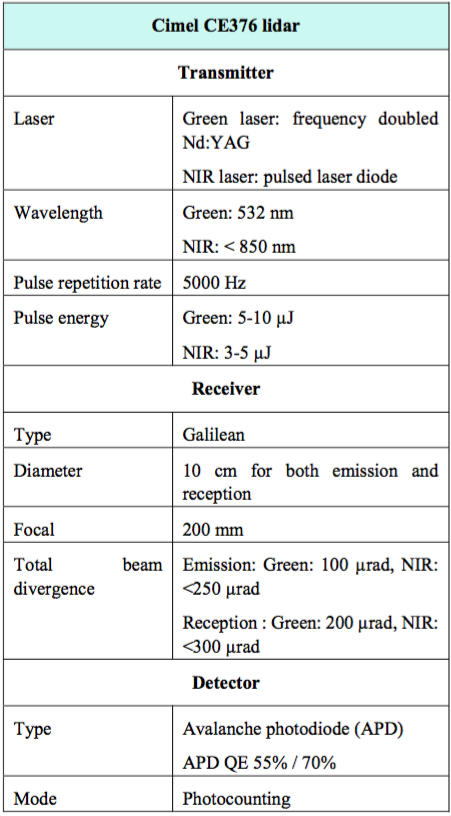
References
Barreto, Á., Román, R., Cuevas, E., Berjón, A. J., Almansa, A. F., Toledano, C., González, R., Hernández, Y., Blarel, L., Goloub, P., Guirado, C., and Yela, M.: Assessment of nocturnal aerosol optical depth from lunar photometry at the Izaña high mountain observatory, Atmos. Meas. Tech., 10, 3007-3019, https://doi.org/10.5194/amt-10-3007-2017, 2017.
Benedetti, A., Reid, J. S., Knippertz, P., Marsham, J. H., Di Giuseppe, F., Rémy, S., Basart, S., Boucher, O., Brooks, I. M., Menut, L., Mona, L., Laj, P., Pappalardo, G., Wiedensohler, A., Baklanov, A., Brooks, M., Colarco, P. R., Cuevas, E., da Silva, A., Escribano, J., Flemming, J., Huneeus, N., Jorba, O., Kazadzis, S., Kinne, S., Popp, T., Quinn, P. K., Sekiyama, T. T., Tanaka, T., and Terradellas, E.: Status and future of numerical atmospheric aerosol prediction with a focus on data requirements, Atmos. Chem. Phys., 18, 10615-10643, https://doi.org/10.5194/acp-18-10615-2018, 2018.
Che, H., Qi, B., Zhao, H., Xia, X., Eck, T. F., Goloub, P., Dubovik, O., Estelles, V., Cuevas-Agulló, E., Blarel, L., Wu, Y., Zhu, J., Du, R., Wang, Y., Wang, H., Gui, K., Yu, J., Zheng, Y., Sun, T., Chen, Q., Shi, G., and Zhang, X.: Aerosol optical properties and direct radiative forcing based on measurements from the China Aerosol Remote Sensing Network (CARSNET) in eastern China, Atmos. Chem. Phys., 18, 405-425, https://doi.org/10.5194/acp-18-405-2018, 2018.
Cuevas, E., Romero-Campos, P. M., Kouremeti, N., Kazadzis, S., García, R. D., Barreto, A., Guirado-Fuentes, C., Ramos, R., Toledano, C., Almansa, F., and Gröbner, J.: Aerosol Optical Depth comparison between GAW-PFR and AERONET-Cimel radiometers from long term (2005–2015) 1-minute synchronous measurements, Atmos. Meas. Tech. Discuss., https://doi.org/10.5194/amt-2018-438, 2018.
Cuevas, E., Romero-Campos, P. M., Kouremeti, N., Kazadzis, S., Räisänen, P., García, R. D., Barreto, A., Guirado-Fuentes, C., Ramos, R., Toledano, C., Almansa, F., and Gröbner, J.: Aerosol optical depth comparison between GAW-PFR and AERONET- Cimel radiometers from long-term (2005–2015) 1 min synchronous measurements, Atmos. Meas. Tech., 12, 4309– 4337, https://doi.org/10.5194/amt-12-4309-2019, 2019.
García, R. D., García, O. E., Cuevas, E., Cachorro, V. E., Barreto, A., Guirado-Fuentes, C., Kouremeti, N., Bustos, J. J., Romero- Campos, P. M., and de Frutos, A. M.: Aerosol optical depth retrievals at the Izaña Atmospheric Observatory from 1941 to 2013 by using artificial neural networks, Atmos. Meas. Tech., 9, 53-62, doi:10.5194/amt-9-53-2016, 2016.
García, R.D., O.E. García, E. Cuevas and J.J. Bustos, Long-term aerosol optical depth (1941-2017) at the Izaña Observatory. 9th Internatıonal Workshop on Sand/Dust storms and Assocıated Dustfall, La Laguna, Tenerife, Spain, 22-24 May 2018.
Kazadzis, S., Kouremeti, N., Diémoz, H., Gröbner, J., Forgan, B. W., Campanelli, M., Estellés, V., Lantz, K., Michalsky, J., Carlund, T., Cuevas, E., Toledano, C., Becker, R., Nyeki, S., Kosmopoulos, P. G., Tatsiankou, V., Vuilleumier, L., Denn, F. M., Ohkawara, N., Ijima, O., Goloub, P., Raptis, P. I., Milner, M., Behrens, K., Barreto, A., Martucci, G., Hall, E., Wendell, J., Fabbri, B. E., and Wehrli, C.: Results from the Fourth WMO Filter Radiometer Comparison for aerosol optical depth measurements, Atmos. Chem. Phys., 18, 3185-3201, https://doi.org/10.5194/acp-18-3185-2018, 2018.
Román, R., B. Torres,D. Fuertes,V.E. Cachorro,O. Dubovik,C. Toledano,A. Cazorla,A. Barreto,J.L. Bosch,T. Lapyonok,R. González,P. Goloub,M.R. Perrone,F.J. Olmo,A. de Frutos,L. Alados-Arboledas: Remote sensing of lunar aureole with a sky camera: Adding information in the nocturnal retrieval of aerosol properties with GRASP code, Remote Sensing of Environment, 196, 238-252, https://doi.org/10.1016/j.rse.2017.05.013, 2017.
Toledano, C., González, R., Fuertes, D., Cuevas, E., Eck, T. F., Kazadzis, S., Kouremeti, N., Gröbner, J., Goloub, P., Blarel, L., Román, R., Barreto, Á., Berjón, A., Holben, B. N., and Cachorro, V. E.: Assessment of Sun photometer Langley calibration at the high-elevation sites Mauna Loa and Izaña, Atmos. Chem. Phys., 18, 14555-14567, https://doi.org/10.5194/acp-18-14555-2018, 2018.
Torres, B., Dubovik, O., Fuertes, D., Schuster, G., Cachorro, V. E., Lapionok, T., Goloub, P., Blarel, L., Barreto, A., Mallet, M., Toledano, C., and Tanré, D.: Advanced characterization of aerosol properties from measurements of spectral optical depth using the GRASP algorithm. Atmos. Meas. Tech., 10, 3743- 3781. https://www.atmos-meas-tech.net/10/3743/2017/, 2017.
Staff
Dr Emilio Cuevas (AEMET; Head of programme)
Dr Carmen Guirado Fuentes (UVA/AEMET; Research Scientist) left IARC in September 2019
Dr Yballa Hernández-Pérez (AEMET; Research Scientist) left IARC in November 2018
Pedro Miguel Romero (AEMET; Research Scientist) Ramón Ramos (AEMET; Head of Infrastructure)
Dr África Barreto (CIMEL; Research Scientist)
Dr Rosa García (Air Liquide; Research Scientist)
Dr Alberto Berjón (AEMET; Research Scientist)
Dr Sergio Fabián León Luis (AEMET; Research Scientist)
Dr Omaira García (AEMET; Research Scientist)
Fernando Almansa (CIMEL/UVA; Research Scientist)
Dr Victoria Cachorro (University of Valladolid; Head of Atmospheric Optics Group)
Dr Ángel de Frutos (University of Valladolid Atmospheric Optics Group; Research Scientist)
Dr Margarita Yela (INTA; Co-PI in MPL sub-programme)
